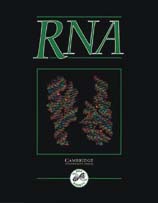Cis-acting elements are required for selenium regulation of glutathione peroxidase-1 mRNA levels
Published online by Cambridge University Press: 01 July 1998
Abstract
Classical glutathione peroxidase (GPX1) mRNA levels can decrease to less than 10% in selenium (Se)-deficient rat liver. The cis-acting nucleic acid sequence requirements for Se regulation of GPX1 mRNA levels were studied by transfecting Chinese hamster ovary (CHO) cells with GPX1 DNA constructs in which specific regions of the GPX1 gene were mutated, deleted, or replaced by comparable regions from unregulated genes such as phospholipid hydroperoxide glutathione peroxidase (GPX4). For each construct, stable transfectants were pooled two weeks after transfection, divided into Se-deficient (2 nM Se) or Se-adequate (200 nM Se) medium, and grown for an additional four days. On day of harvest, Se-deficient GPX1 and GPX4 activities averaged 13 ± 2% and 15 ± 2% of Se adequate levels, confirming that cellular Se status was dramatically altered by Se supplementation. RNA was isolated from replicate plates of cells and transfected mRNA levels were specifically determined by RNase protection assay. Analysis of chimeric GPX1/GPX4 constructs showed that the GPX4 3′-UTR can completely replace the GPX13′-UTR in Se regulation of GPX1 mRNA. We did not find any GPX1 coding regions that could be replaced by the corresponding GPX4 coding regions without diminishing or eliminating Se regulation of the transfected GPX1 mRNA. Further analysis of the GPX1 coding region demonstrated that the GPX1 Sec codon (UGA) and the GPX1 intron sequences are required for full Se regulation of transfected GPX1 mRNA levels. Mutations that moved the GPX1 Sec codon to three different positions within the GPX1 coding region suggest that the mechanism for Se regulation of GPX1 mRNA requires a Sec codon within exon 1. Lastly, we found that addition of the GPX1 3′-UTR to β-globin mRNA can convey significant Se regulation to β-globin mRNA levels when a UGA codon is placed within exon 1. We conclude that Se regulation of GPX1 mRNA requires a functional selenocysteine insertion sequence (SECIS) in the 3′-UTR and a Sec codon followed by an intron.
Keywords
Information
- Type
- Research Article
- Information
- Copyright
- © 1998 RNA Society
- 62
- Cited by

